Olivier Pantaloni led his long-time club, Ajaccio, to Ligue 1 in 2021/22 as L’ours achieved a second-place finish in Ligue 2 to return to the top flight — where they’ll face the likes of PSG, Lyon, Lille, Marseille and Monaco — for the first time since 2013/14 when they were last relegated from Ligue 1. They achieved promotion this past season while boasting the best defensive record in France’s second tier. Ajaccio conceded just 19 goals during 2021/22, a staggering ratio of just one goal every two games.
Of course, life will be more difficult next season and they need to get their summer recruitment right, first and foremost, if they’re to survive in Ligue 1 next term. In our view, they’ve gotten off to a great start, in that regard, by signing a midfielder with vast experience in the top flight, Thomas Mangani (183cm/6’0″, 79kg/174lbs) on a free after the 35-year-old ended his seven-year stint at Angers at the end of the 2021/22 season, with his Angers tenure beginning back in 2015 when he joined from then-Serie A side Chievo Verona — a club for which he made just one league appearance, that coming against Juventus. While the early-to-middle part of his career was difficult, Mangani has truly established himself as worthy of playing in one of Europe’s best leagues in the mid-to-latter stage of his career.
Mangani joins Ajaccio, where he spent the 2007/08 season on loan from Monaco, off the back of an impressive campaign in which he appeared in 33 of Angers’ Ligue 1 games, scoring seven goals and providing two assists. This was the most prolific season of the 35-year-old’s career in front of goal and he played a key role in Gérald Baticle’s side despite his age. We feel he can continue to play a key role in France’s top flight for newly-promoted Ajaccio next season and this tactical analysis and scout report aims to explain why via analysis of Mangani in the 2021/22 campaign as well as by making some points on Ajaccio’s strategy and tactics to discuss what we believe their plans for their new midfielder may be.
Could this prove to be a decisive transfer in Ligue 1’s relegation battle next season? Only time will tell, really, if the midfielder lives up to his recent claims that he’s joining Ajaccio “with a lot of motivation”, but we certainly feel Mangani has the potential to be a massive difference-maker for Ajaccio at the lower end of the table. All stats and data used in this analysis come from Wyscout unless otherwise stated.
Defensive qualities
Adam Scully analysed Ajaccio and their defensive tactics for Total Football Analysis earlier this year and I’d highly recommend reading that piece to fill yourself in on the relevant details regarding how Mangani’s new team liked to defend in 2021/22. Ajaccio tend to defend in a 4-4-2 mid-block, primarily, using specific pressing triggers as cues to jump into a more aggressive press. For the most part, however, they’re not incredibly aggressive, firstly prioritising organisation in their 4-4-2 and waiting for the opposition to give them a chance to win the ball back.
I believe this kind of defensive system would suit Mangani down to the ground. At 35, as you might imagine, he’s not really a guy who you’ll typically see charging around the middle of the park pressing with great intensity and relying on his physical traits. Instead, Mangani relies on his positioning and ability to read the game, first and foremost.
Don’t take this to mean Mangani doesn’t offer a lot without the ball — he absolutely does. The midfielder made an impressive 9.72 successful defensive actions per 90 this season, ranking highly among Ligue 1 midfielders for that particular metric. He made a lot of interceptions (4.88 per 90) and engaged in 7.74 defensive duels per 90, though only managed a below-average 59% defensive duel success rate, which he probably won’t be overly pleased with. We’ll discuss more on that later but firstly, let’s look at Mangani’s interception-making ability, which is highly impressive.
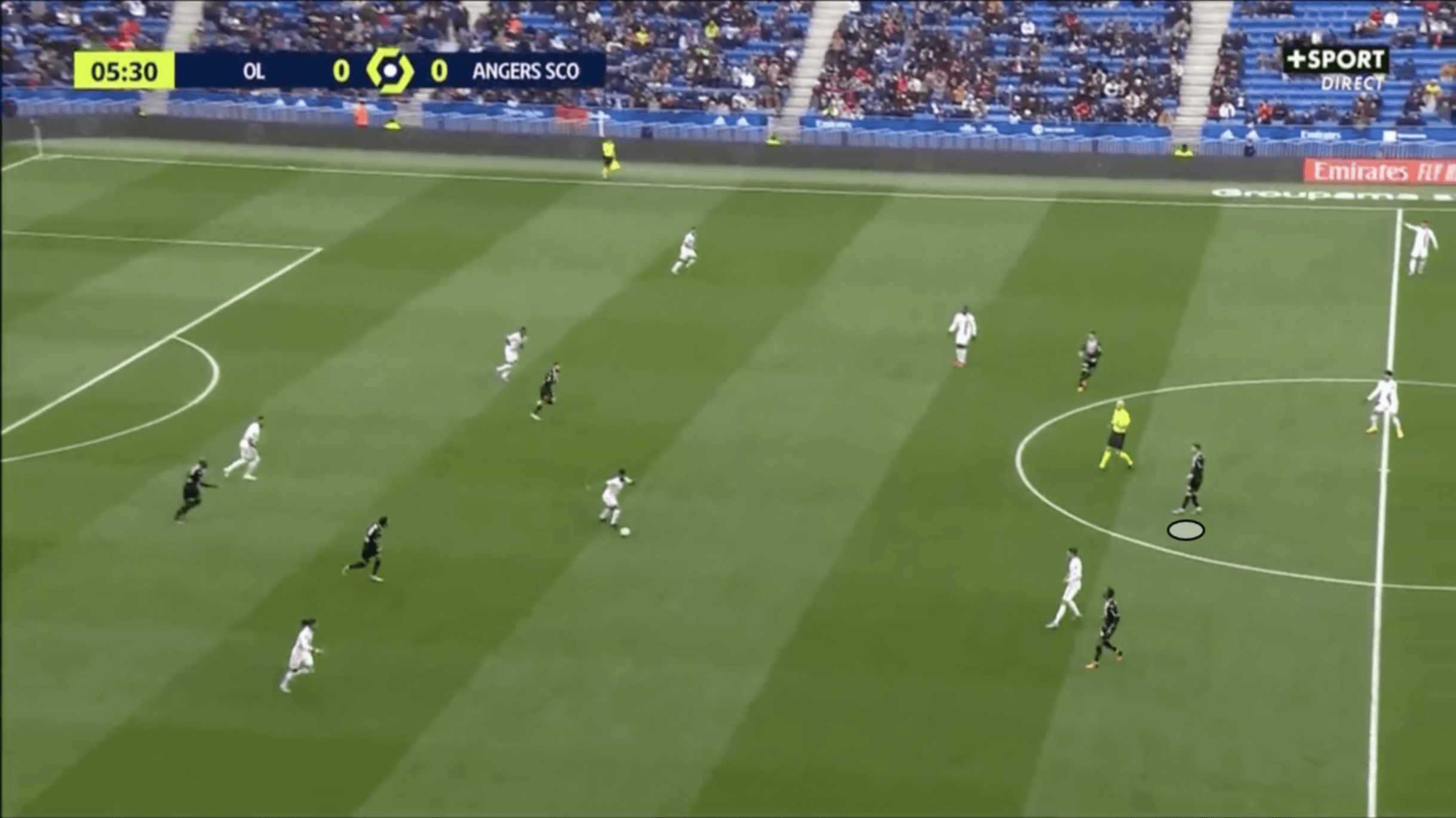
Figures 1-2 look at Mangani’s interception-making ability. Starting with figure 1, here we see the opposition on the ball just entering the middle third of the pitch, having gotten through Angers’ first line of pressure. This left Mangani and his two midfield partners on either side of him to protect the middle of the park and prevent the opposition from easily cutting through them again.
We see Mangani circled in figure 1. In this game, he played as the central — and deepest — midfielder in Angers’ 3-5-2 system. The left-footed deep-lying playmaker generally operated as either the central midfielder or the left central midfielder in this system, most of the time, operating as the former.
In figure 1, the midfielder’s focus is on spatial awareness, patrolling his zone and shifting over to the left side of the pitch as his team’s left central midfielder shifts over to protect against the opposition ball carrier and his attempts to break through Angers’ midfield.
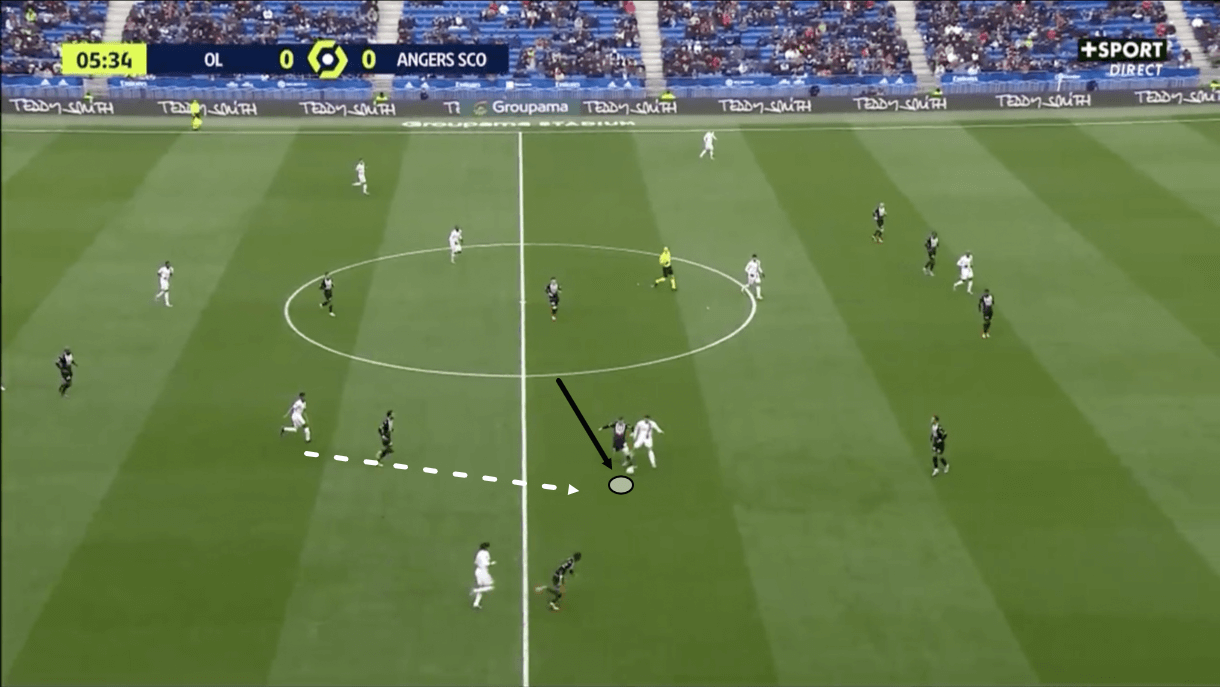
Mangani just has to focus on controlling his zone, scanning to maintain spatial awareness and ensuring that the opposition’s most dangerous passing lanes are blocked off. He does this excellently in this example. As the opposition ball carrier came forward with the ball, a teammate made a run into some space, targeting the gap between Mangani and his left central midfielder. Mangani remained well aware of the ball carrier’s intent and the runner’s movement, however, and managed to position himself well enough to burst in front of the intended receiver just before the ball reached him, as we see in figure 2.
The 35-year-old needed to use a burst of pace to dart in front of the receiver as the pass was played but he limited the amount of energy he needed to expend through his spatial awareness and excellent positioning. This is what he constantly relied on defensively last season and this is a big part of the reason why he made so many interceptions.
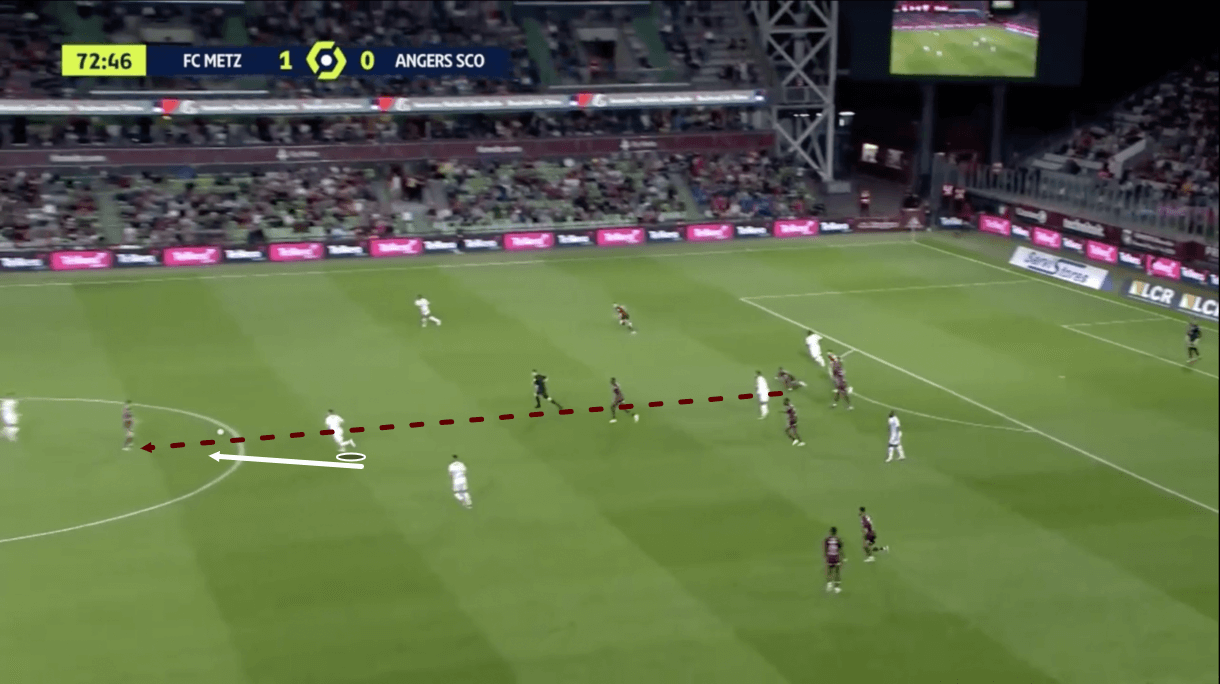
Figures 3-4 show an example of what it can look like should Mangani not get his positioning right immediately as the opposition pass is played forward to the receiver in the more advanced position. Shortly before this image, Angers were in possession, attempting to break down the opposition in the final third. However, the ball was turned over and the opposition were able to send the ball to the free man in central midfield behind Mangani to kickstart their counterattack. When Angers were in possession, Mangani picked up a different position to try and help his team break the opposition down and didn’t remain focused enough on the opposition attacker’s positioning. As the player receives behind Mangani here, one of Angers’ centre-backs is dragged out of the backline to confront the receiver while Mangani has to quickly track back.
The poor positioning and failure to cut the passing lane leaves Mangani in a position of defensive recovery rather than the more proactive position we saw him in the previous passage of play. Now, he’s forced to expend more energy and rely more on his physicality to defend — not ideal for the 35-year-old in terms of sustaining his level for the full 90 minutes. As a result, we see how Mangani’s spatial awareness can actually let him down at times when defending in a more open space and in a non-settled defensive phase (as opposed to the settled, organised mid-block we saw him operating in for figures 1-2). He can struggle, at times, in transition. If Mangani gets dragged forward during the possession phase, it’s imperative that his midfield partner or one of his midfield partners cover for him and patrol the central space in front of the backline to avoid this kind of incident.
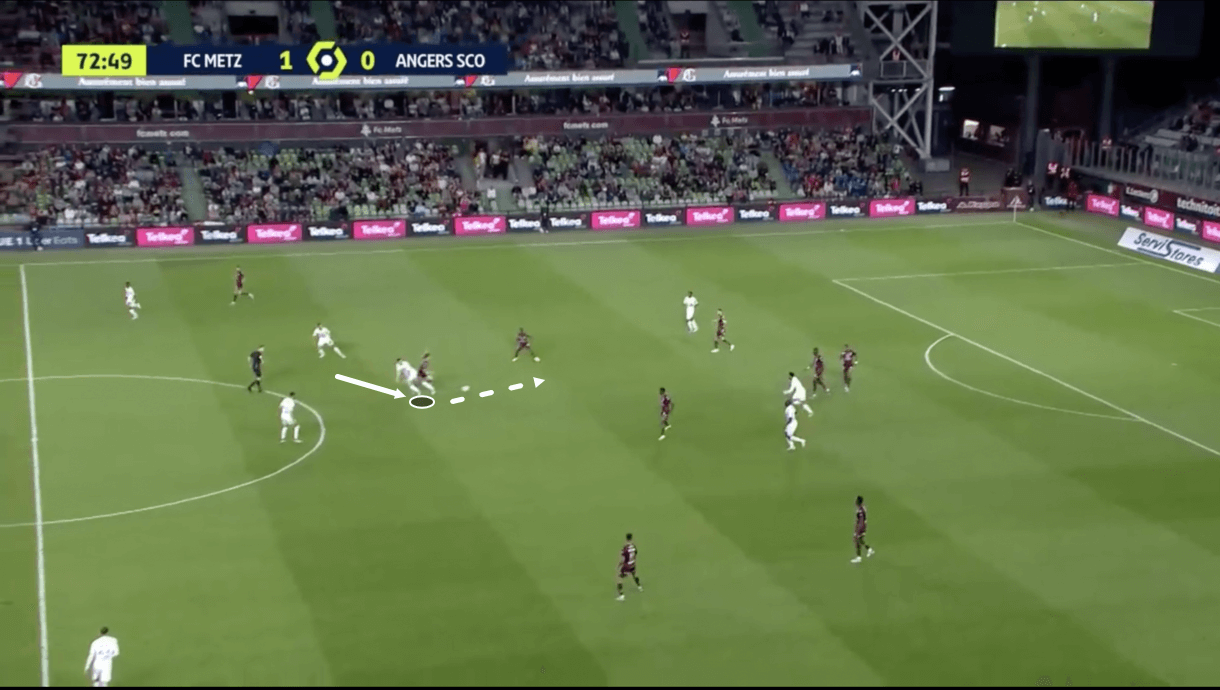
As the play moves on into figure 4, we see that largely thanks to the centre-back’s quick reaction and good defending to halt the attacker’s progress, Mangani did manage to get back and stick a foot in to win the defensive duel and dispossess that opposition player. However, the tackle was fairly weak and only sent the ball back as far as the next opposition midfielder just behind the player he’s dispossessed. This isn’t a one-off and actually shows us an example of another concerning element of Mangani’s defensive game — his lack of physicality. The 35-year-old doesn’t tend to enter defensive duels very strongly and sometimes even when his technical defending is good enough to dispossess the attacker, his tackle is too weak and only results in another, near opposition attacker taking control of the ball, making Mangani’s contribution far less significant. Additionally, Mangani isn’t incredibly strong despite his decent size and can be outmuscled, as well as beaten aerially.
So, it’s worth noting that while Mangani is a fantastic asset in an organised defensive phase, such as the mid-block, where his focus was more on remaining aware of movement around him, cutting passing lanes and making interceptions, he struggles when forced to defend more aggressively and isn’t the greatest asset in defensive transitions, at times.
Again, in terms of physicality, we have seen Mangani remain defensively active late on in games. He’s got a fighting spirit and consistently applies pressure when required for over 90 minutes but there is a bit of a dropoff in his energy levels and amount of successful defensive actions achieved later on in games so this is another reason why his energy levels need to be conserved throughout a game and not unnecessarily diminished as they were in figures 3-4, as well as a reason why his minutes will need to be managed and watched carefully next season. Mangani can be a great asset for Ajaccio but they must be careful to use him wisely and keep him healthy. He’s no use to them exhausted or injured.
Progression
Moving on to look at what Mangani offers in possession, the 35-year-old stands out as one of the best deep-lying ball progressors in France’s top tier for 2021/22, which is something he should absolutely be able to carry over to his next club, again, provided he remains in good condition.
The midfielder made a very high number of progressive passes (8.79 per 90) for a Ligue 1 midfielder in 2021/22, with an above-average 77.53% success rate. Indeed, his progressive pass success rate could be better still and this is indicative of Mangani’s style; he’s a creative risk-taker who’ll be an excellent asset for a side in transition to attack or in creating chances from deep in a settled possession phase too because he’s happy to take chances and risk losing the ball for the reward of sending a teammate through into a high-value goalscoring opportunity. This can be a negative given that Mangani isn’t always great at defending in transition but if his team accounts for that and puts safeguards in place via other players in case the ball is turned over, then that may help to reduce the significance of that negative.
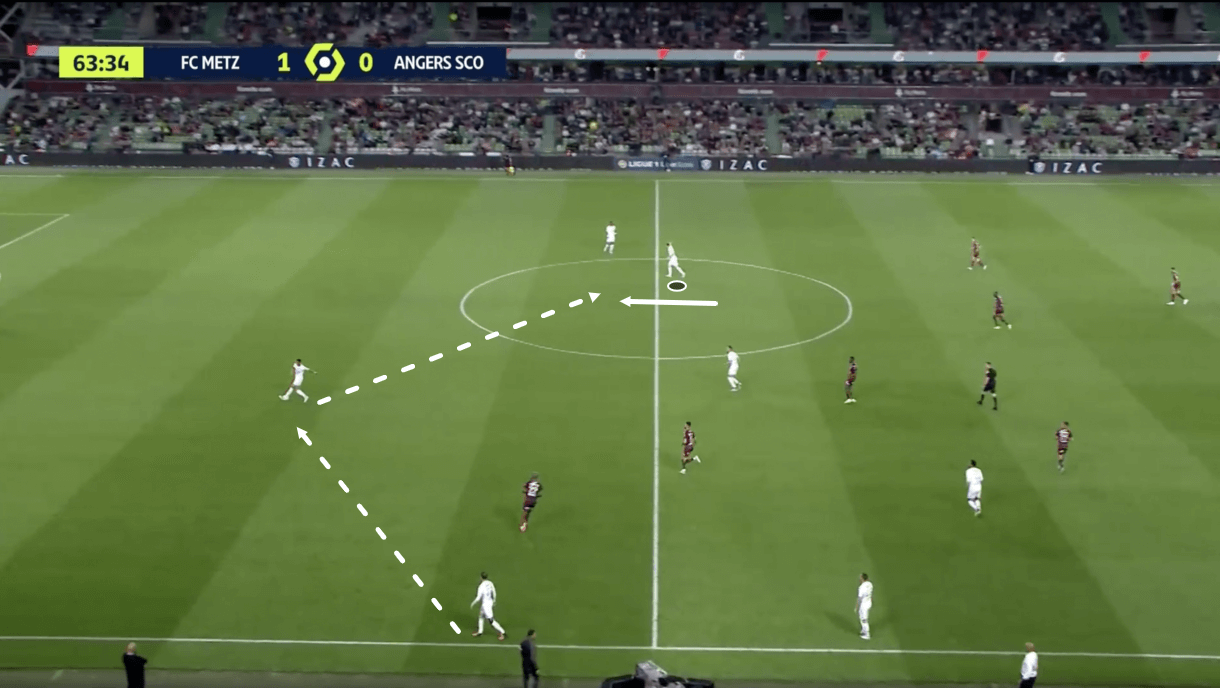
Figures 5-7 show our first example of Mangani’s ball progression capabilities. Firstly, in figure 5, we see the midfielder dropping deep into space from his left central midfielder position as his team plays the ball from the wide right player to the central defensive player. As he drops, we can see the midfielder directing his near teammate on the left to push out wide, knowing that they were both pretty much occupying the same space at this moment and would need to spread out to maximise their potential for hurting the opposition. This shows some of Mangani’s leadership and tactical understanding, as well as good spatial awareness.
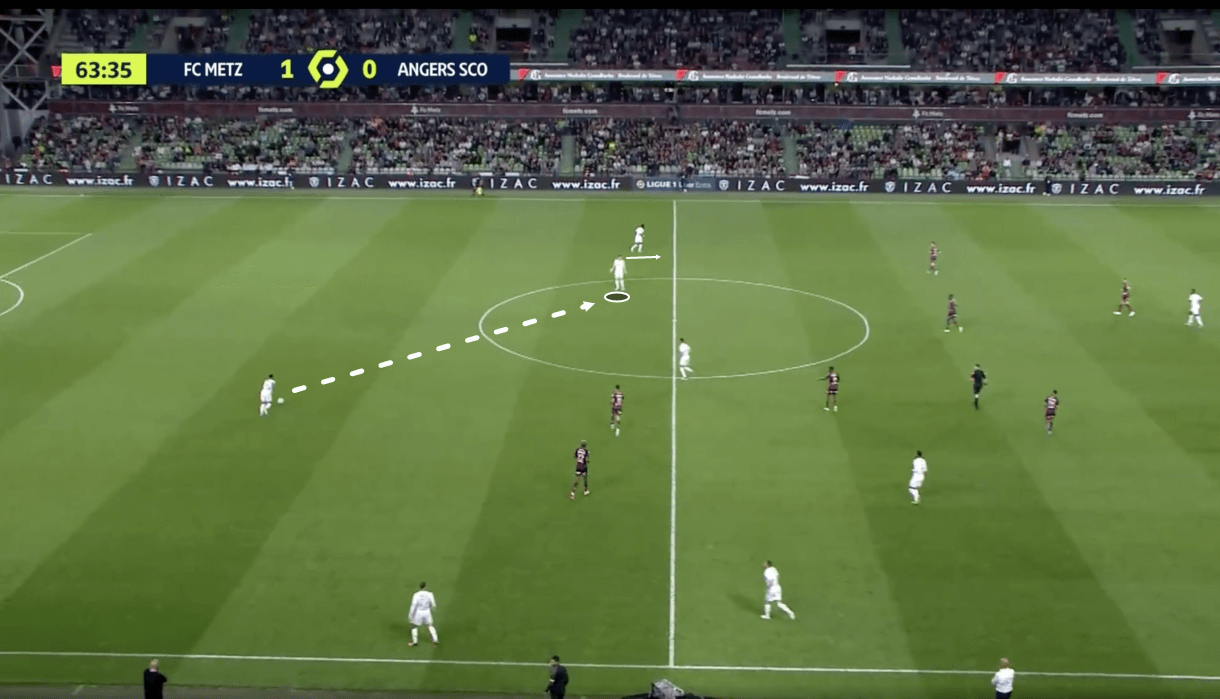
Mangani gets in position to receive the ball in figure 6, as the nearest teammate to him makes his way out wide, with the 35-year-old evidently scanning over his left shoulder at this moment to ensure he’s not coming under any major pressure from the opposition and to check for his teammates’ positioning further upfield to help speed up his decision-making after receiving the ball. He scans at a good time here, just in between his teammate’s touches when he has a fraction of a second to take his eye off the ball and look over his shoulder safely. From here, he receives the ball well, taking it on the half-turn and quickly facing forward, which is where we move on into figure 7.
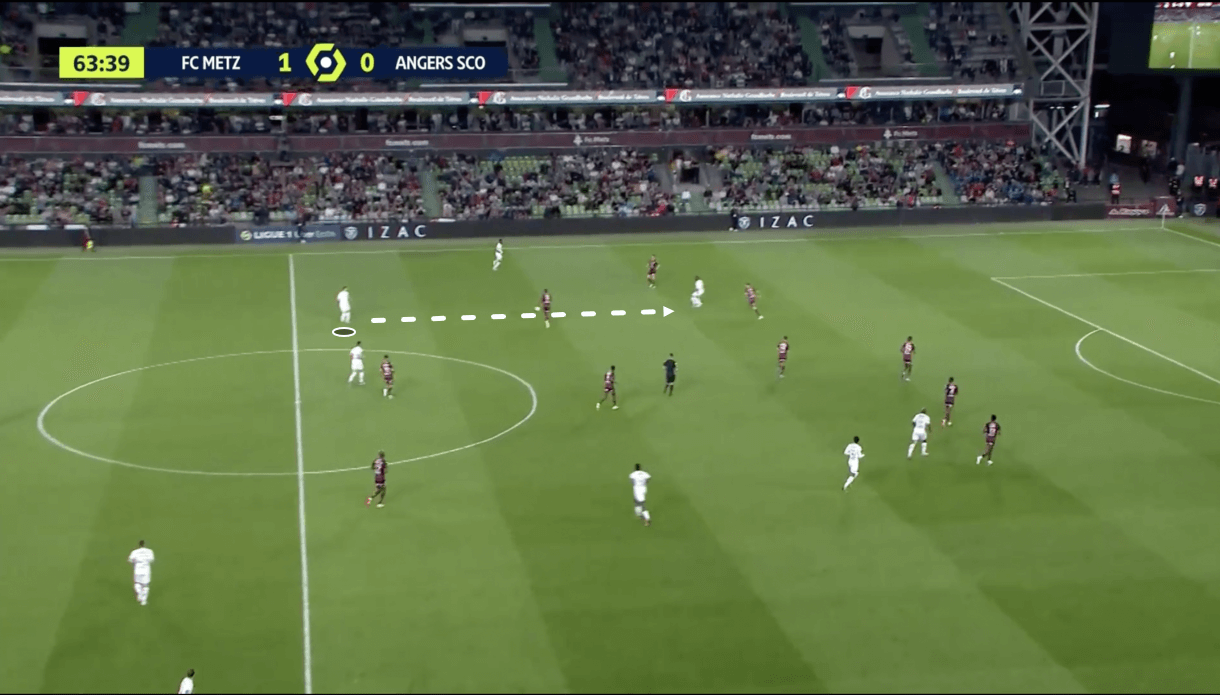
In figure 7, we see that Mangani carried the ball slightly forward and slightly to the deep left half-space. From here, he sends the ball forward to a teammate with his back to goal advanced further upfield in the left half-space. This teammate can then receive the ball with enough space to turn and run at the defence; so, we can see how Mangani’s contribution, from his initial movement to his scanning to his execution of the progressive pass all served to put his team in a far better position and actually set up a good attacking opportunity. We saw him doing this regularly for Angers both from the holding midfield position and the left central midfield position — he very much played a creative, progressive role and Ajaccio would be wise to use him similarly.
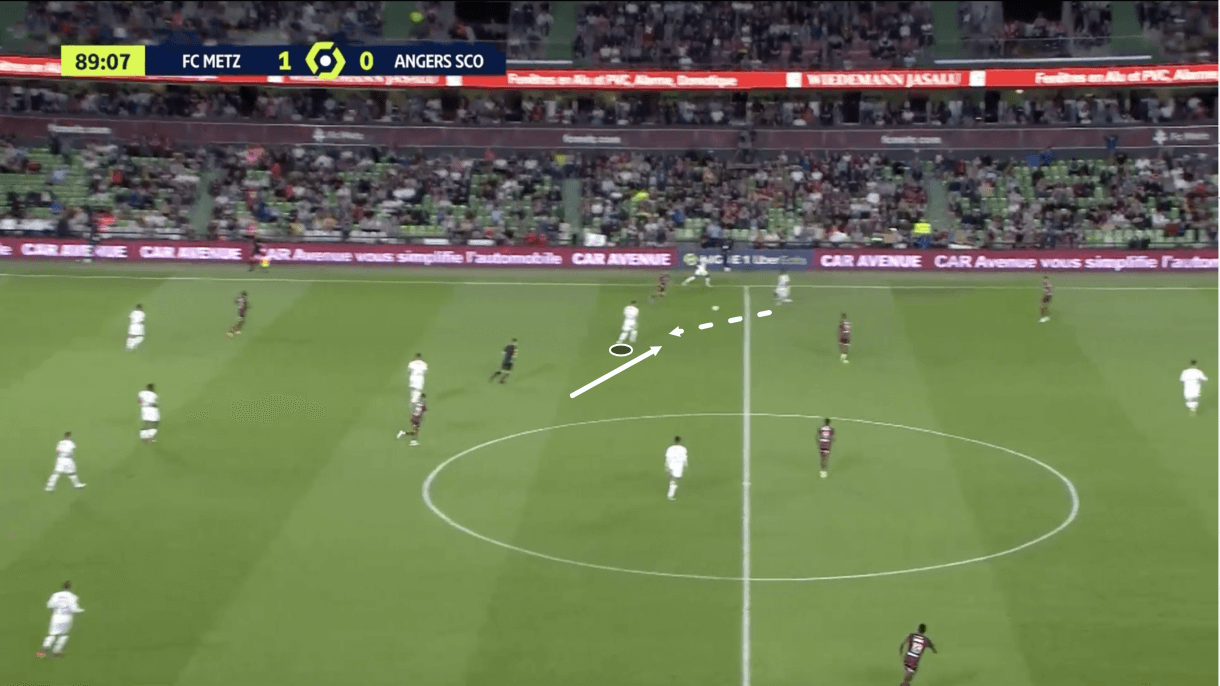
Figures 8-9 show another similar example of Mangani’s ball progression ability. Here in figure 8, we see the midfielder receiving the ball. Just before this image, Angers regained possession on their left wing, and Mangani shifted out towards the ball carrier to support. I believe this highlights an area of weakness within the 35-year-old’s game — he often gets too close to teammates when looking to give them a passing option. Sometimes, the better way to support a teammate is by staying at a distance or even by moving further away. This can create better angles for your teammate and for yourself with the follow-up pass, make it easier to weigh the pass if they chose to use you and keep the opposition stretched, as opposed to condensing all in one area. This tendency to get too close to teammates when offering a passing option has resulted in turnovers or simply reduced passing options for teammates at times this season and is something that Mangani should be more aware of.
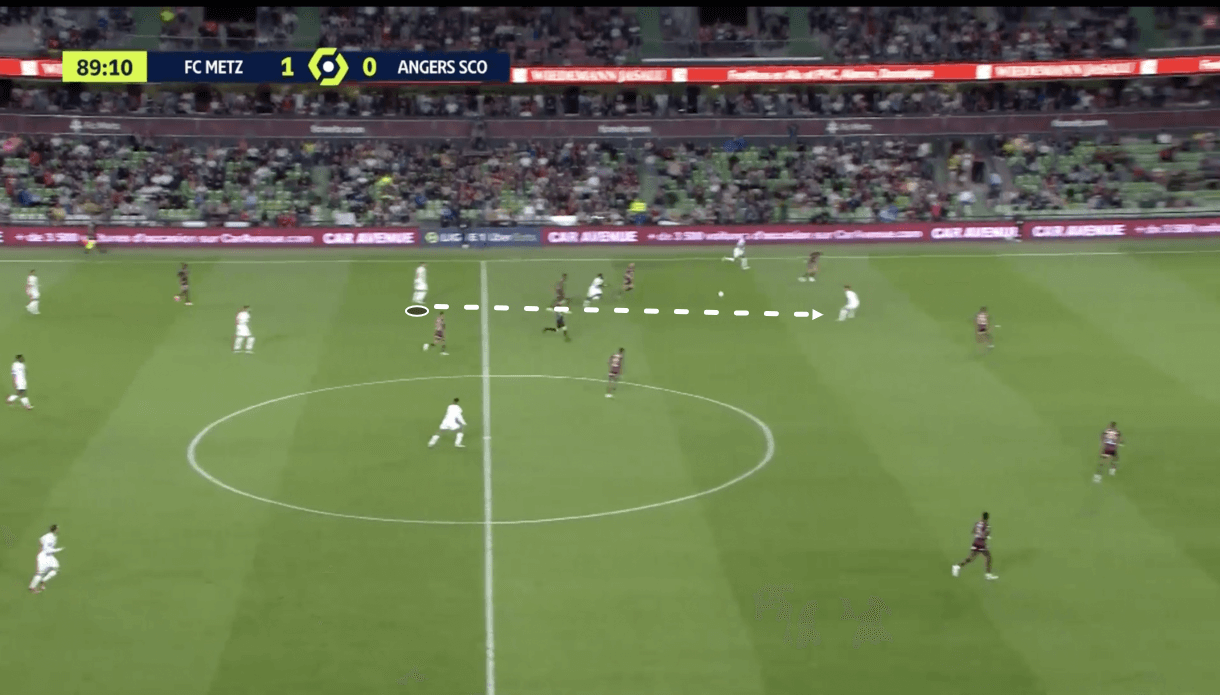
Regardless of that, what the midfielder does after receiving the ball here was a joy to watch and shows why he was so valuable for Angers in the deep-lying playmaker role. The 35-year-old quickly engineers a passing angle into one of his striker’s feet again, once more setting them up in space to turn and run at the opposition’s backline from the left half-space. Mangani loves occupying the deep left half-space and progressing vertically through to the advanced left half-space where one of his team’s creative dribblers can take over and torment the opposition’s backline.
I’m confident that Mangani will retain his self-belief, risk-taking nature and vision on arrival at Ajaccio, it’s now up to Ajaccio to 1. Put him in the correct role in which he can flourish and 2. Take good care of him to ensure he stays in top condition. If they do that, they have one of Ligue 1’s best deep-ball progressors to play with which will be a massive help in their bid for top-flight survival; if it weren’t for his age, Mangani would be valued much more highly with his current level of quality.
Long passing and crossing
For the third and final section of this scout report, I want to look at what Mangani can offer in terms of chance creation. As a set-piece and penalty-taking specialist, Ajaccio have a very valuable asset in Mangani and he’ll aid the newly-promoted side’s goal threat simply via his wand of a left foot on corners and free-kicks, as well as offering experienced reliability along with great quality from the spot; these are some other traits that could prove vital in the Ligue 1 race for survival.
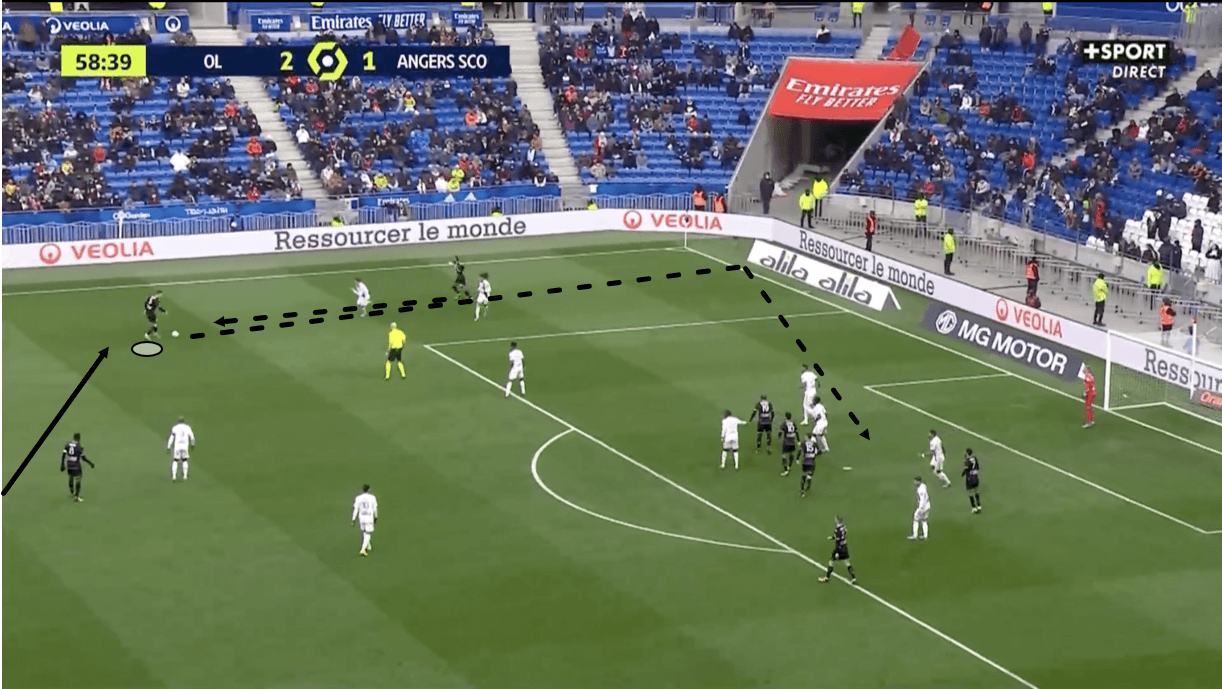
Mangani doesn’t just offer a chance creation threat from set-pieces, however, he also offers a threat from open play, which figure 10 shows an example of. Here, the midfielder has shifted out from his left central midfielder position to the left-wing, having just offered support to the left-winger and received in plenty of space in the deeper position we see him occupying. This is the kind of crossing position that Mangani loves; the 35-year-old likes to get into wide deep crossing positions with space to measure his upcoming pass perfectly, as he does on this occasion. It was common to see Mangani shift out from central midfield to the wing, operating almost as a left-back might in the chance creation phase when the ball was on the left-wing. His team was happy for him to play that role due to the quality of ball he was capable of delivering.
On this occasion, the midfielder’s out-swinging cross bounced into a teammate’s path and set up a goal for Angers, highlighting how deadly this kind of ball from Mangani can be. I think it’d be wise for Ajaccio to find a way of capitalising on Mangani’s crossing threat next season thanks to the immense technical quality and vision he possesses.
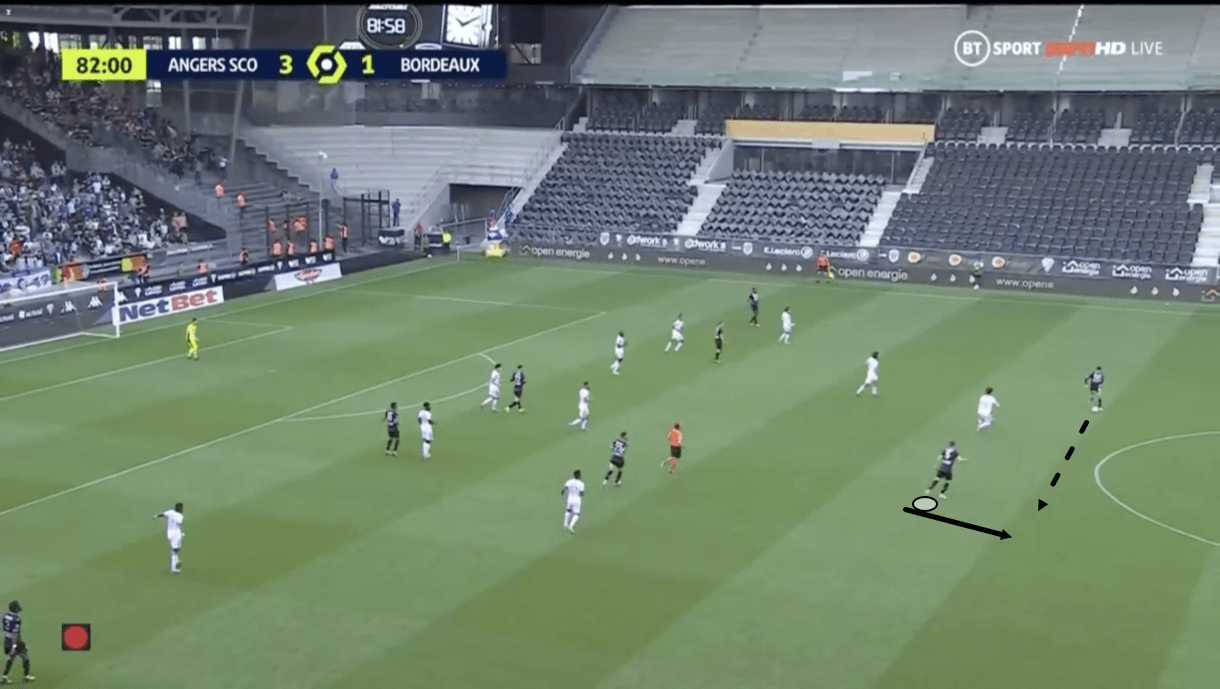
Mangani is excellent at dictating play from his deep midfield position in the ball progression phase and in the chance creation phase, with Angers in the latter in figure 11. He played a very high number of long passes (6.54 per 90) last season with a decent (66.27%) success rate. Suppose the team has an organised offensive shape with a player sitting wide on each wing and attackers with intelligent movement in more central positions. In that case, Mangani can hurt you with the ball at his feet in a deeper position. If the opposition stretches out to retain greater access to the wide passing options, enough space will open between the lines for Mangani to thread the ball through. Meanwhile, if the opposition gets very compact and narrow to protect the centre, then Mangani has the vision, confidence and technical long passing ability to spread the ball around the pitch and force the opposition to move.
In figure 11, we see the midfielder intelligently moving at just the right moment to free himself from the opposition forward’s cover shadow and make himself available for his teammate on the ball to pass to. As play moves on from here, we see Mangani receive the ball while allowing it to roll across his body and onto his stronger left foot, which he’ll plan to use for chance creation from here.
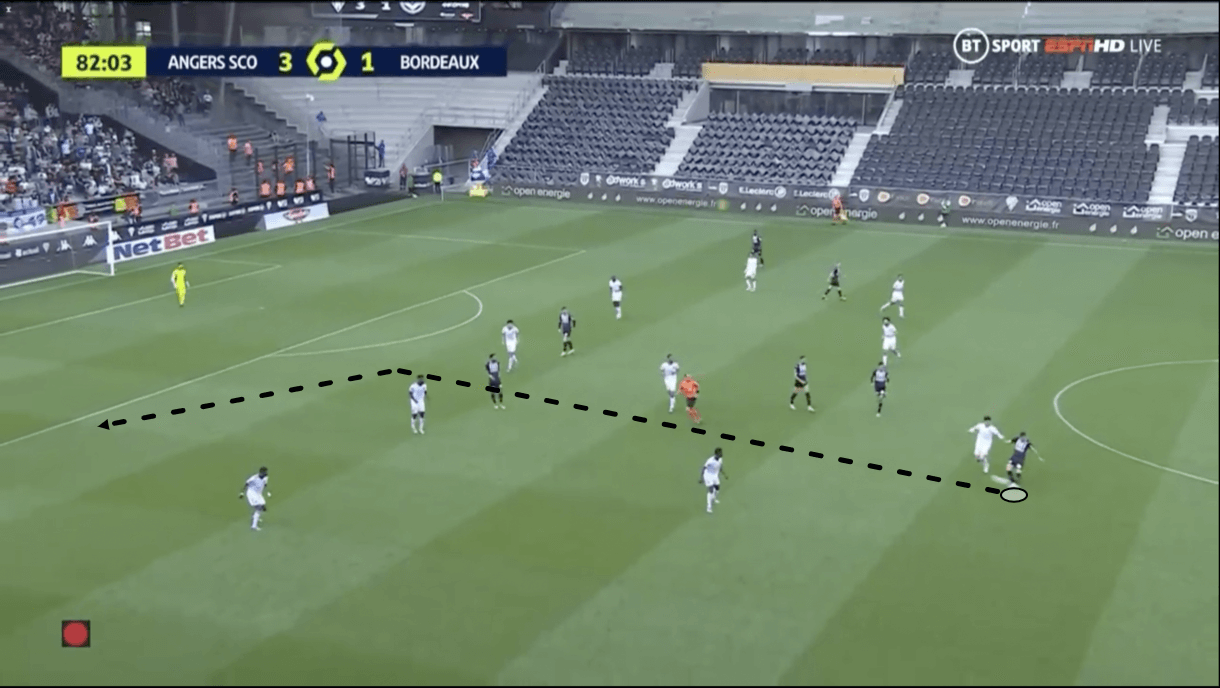
Entering figure 12, we see that the midfielder has waited until the opposition’s pressing forward has gotten close to him before releasing the ball. This is typical of Mangani, who is generally really good at finding space on the pitch but once on the ball, is generally happy to attract pressure while possessing the mental and technical ability to handle it, either via some quick short-distance dribbling or by just using all of the time he has to compose himself before releasing the pass, as was the case in this example.
Remember, Mangani is a risk-taker. The midfielder is happy to take the risky option if it’s also a good one, while being comfortable with losing the ball to take the chance of winning big and setting his attackers up for a good goalscoring opportunity.
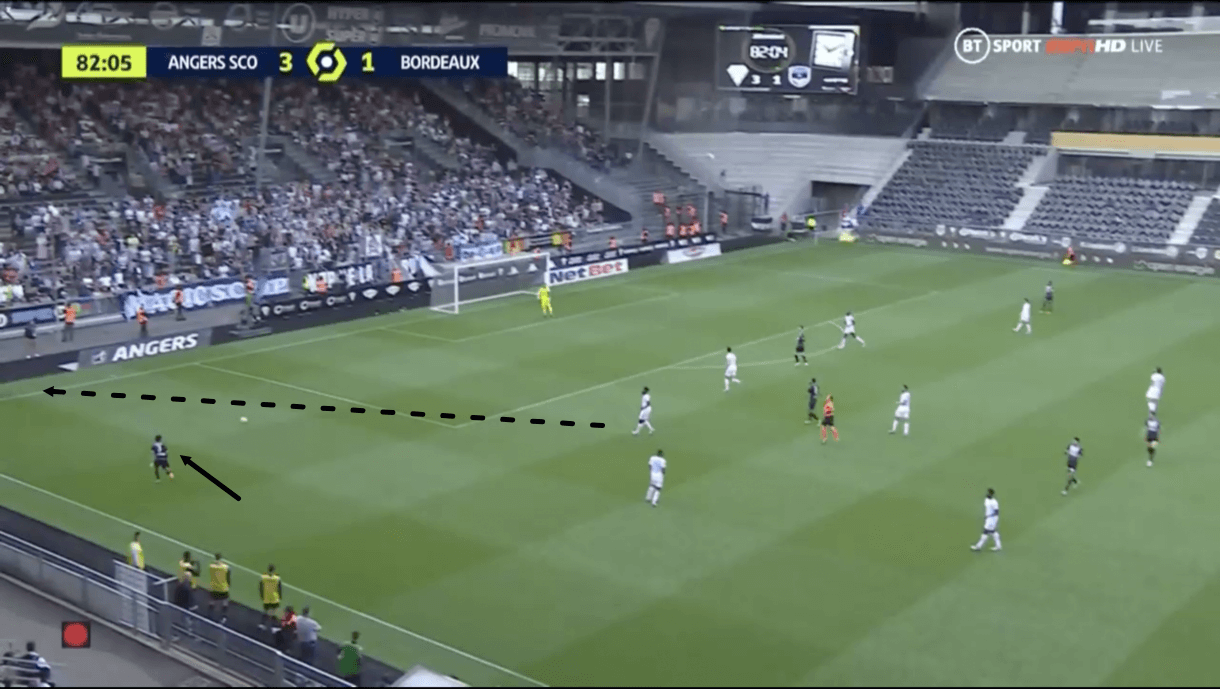
On this occasion, the 35-year-old’s lofted through pass had too much weight on it and ultimately went out of play before the wide man chasing it down was able to get to the ball. However, this further emphasises the point that yes, Mangani is a risk-taker and his passes don’t always work out. He’s more than happy to sacrifice pass success rate for a chance to create something for his team and while not every player in the squad can be this one, it’s a vital role if a team is to break the opposition down and create chances, so this risk-taking attitude and creative flair from deep, along with a dictator in settled possession, are some things that Mangani can bring to Ajaccio next season.
Conclusion
To conclude this tactical analysis and scout report, it’s clear that Mangani’s strengths lie in defending space in a compact defensive system and making interceptions, along with creative passing from deep, ball progression and dictating play when required via his exquisite long passing quality.
Should Ajaccio stick with their 4-4-2 formation, we think Mangani could very well slot into the left central midfielder position. However, he may be better suited to the left central midfield position in a midfield three. Should Pantaloni be thinking about changing his system for the top flight next term, this is one idea we think he should consider as it’d give Mangani the freedom to progress and create while he should have plenty of cover from his midfield partners defensively and in defensive transition. We believe Mangani has the potential to be a game-changer for Ajaccio in their bid for survival as long as he’s used correctly and protected an adequate amount.




Comments